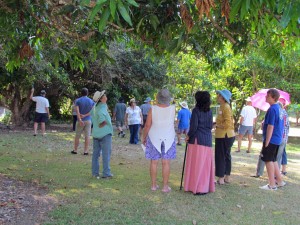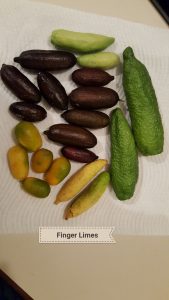Serendipity in Solomon Islands
15/09/2011 // 0 Comments.jpg) An Ausaid project to improve fruit quality and diversity, rediscovers the old orchard research stations lost to the jungle
An Ausaid project to improve fruit quality and diversity, rediscovers the old orchard research stations lost to the jungle
WORDS BY DIGBY GOTTS*
PHOTOGRAPHS BY DIGBY GOTTS
I have been involved with Community Sector Programs in Solomon Island, a non-government local organization supported by AusAid funding, for three years. Working with two local men, we have designed a project to improve fruit quality and diversity throughout the country, and we are now implementing this project.
Local conditions
Solomon Island has a very hot and wet climate, similar to my home at Cape Tribulation but a little hotter most of the year, rarely going below 20C. The climate and soils seem ideal for growing many of the equatorial fruits, but very few make their way to a market anywhere within the country. Fruit sold in markets is typically of very poor quality: fibrous mangos, thin fleshed papaya, small green mandarins, avocado with huge seeds and so on. On a good market day in the capital, Honiara, you might find the odd stall with local sweet oranges or soursop or a good mango at triple the normal price.
Establishing nurseries
The project is intended to train interested people so that they will establish a seedling nursery of some of the fruits that grow well in their region. Once their nursery is completed, we are able to return to give more training on vegetative propagation. Initially people are being asked to identify the best fruiting trees in their region and use these for budwood source material to develop their skills. When they demonstrate continuing commitment and skill, we return with known varietal bud wood. The “we’ll help you more if you participate” model has been deliberately chosen to avoid a cargo cult syndrome. We start by delivering a nursery establishment workshop which ends with the handing over of 100 poly bags to each participant for planting up with seedlings. If that is done, we can give the organizers/lead farmers the shadecloth and cut timber for a small nursery at the workshop location, then pocket knives with sharpening stone and secateurs. After 18 months we have given nursery workshops to around 400 people, handed out 30,000 poly bags and helped to establish 27 lead farmers’ nurseries for demonstration of our expectations. Over September 2009, we completed a first round of propagation workshops at many of the lead farmer nurseries. As they develop confidence and skill, lead farmers are expected to then start running their own workshops for family and community, passing on the knowledge and the opportunity. I have also written a basic text book for use in Solomon Island about the why and how to grow fruit trees. This will be distributed to participants as further backup to the workshops and to encourage their own teaching of the principles involved.
Sourcing the budwood
Originally, we intended to introduce varietal budwood of selected species from Australia but a small miracle allowed us to avoid this costly complication. Five provincial horticulture research stations were established in about 1990 by Solomon Island Ministry of Agriculture, along with a main base of operations outside Honiara. Each of these was planted up with a collection of varietal mango, carambola, guava, rambutan, citrus, avocado, sapodilla and cashew as well as a wide variety of seedling mixed fruits such as jaboticaba, star apple, local canarium (ngali nut), local barringtonia (cut nut), miracle fruit, durian, purple mangosteen, yellow mangosteen, abiu, canistel, black sapote and many more. However, the government failed to make lease payments and villager owners refused government staff access to those blocks. No care or management had been applied for 15 years and most of the trees had died. The management base outside Honiara was also one of the major targets for disaffected elements during the civil unrest in 2000. All buildings were burned and all records, including planting records, were lost in the fires. In 2006, I was taken out to the remote island of Kolumbangara to visit the one orchard remaining on government land. I found many of the fruit trees still there but in a diseased state and buried by the jungle. It was impossible to walk through the orchard. An interesting historical orchard, but useless from a horticulture point of view without knowing what cultivars were present. The agriculture foreman, Roy was still living at the station even though he had been unemployed for 6 years, and showed us around. Roy pulled out his suitcase and produced the original handwritten planting records from 1990 for the orchard. Eureka! We were able to decipher the plans and identify the exact locations of 48 cultivars of mango, 10 carambola and 19 rambutan as well as all the seedling trees and other ‘odd bods’ then lost in the jungle!
Miraculous recovery
Funding was made available and over the last year, Roy and three workers have cleaned up the undergrowth and overgrowth on 3 Ha with bush knives and hand saws. The recovery of the cleaned fruit trees has been remarkable, with everything showing flushes of new growth. We plan to get him a small chainsaw so he can prune the mango and rambutan trees to enable a flush of new tips which can be harvested next year for grafting onto rootstock now being established in his nursery. These grafted plants and bare budwood can then be distributed to lead farmer nurseries for further multiplication and distribution to their circles of influence.
Trifoliata rootstock
The citrus area of this orchard had been totally lost with everything missing or dead. As citrus is not very successful in the region we will use known local fruiting trees for propagation material rather than imported varietal budwood that will probably not survive in the long term. There are good local pommelo, sweet orange, mandarin and red grapefruit that we will be collecting and grafting onto Citrus trifoliata rootstock. Trifoliata has been chosen for its distinctive triple leaf, making it easy for beginner growers to recognize the rootstock suckers and cut them away. Overgrowth from rootstock is the number one killer of budded citrus through the Pacific, so while this choice may not be the best for a commercial planting, it will give the plants a better chance of being looked after. Ten thousand tri seeds have been imported from Australia and distributed to about 10 leading nurseries for potting up. Budding onto these will start by about March 2010.
Future of the project
We are now about half way through the planned lifetime of the formal project. Its success in the long term will depend on it being able to self sustain through the long juvenile period of the fruit trees, when there can be no financial return and none of the quick gains most aid projects rely on for political acceptance. However the joyful participation by so many people in so many workshops, and the sheer number of seedlings already potted up makes me hopeful that the skills of grafting and budding will also be picked up and carried on. I look forward to coming back one day to find some Nam Doc Mai or Jit Lee in the marketplace.
[1172 words]
*Digby Gotts is the co-owner of Cape Trib Exotic Fruit Farm at Cape Tribulation, QLD and has worked as a horticulture consultant for a variety of aid projects in the Pacific.
IMAGES

001 Digby runs a grafting workshop for 45 farmers at Sasaa, Guadalcanal.
002 Roy Vaketo, manager of Ringgi orchard, on Kolumbangara, shows the emerging research orchard, once the rainforest has been cleared.
003 The fruit market at Auki, Malaita.
004 Picking ngali nut (Canarium indicum), an indigenous nut tree in the Solomons
005 Establishing a nursery on Choiseul Island.
006 Getting ready to graft a mango seedling
Similar posts
-

Self Guided Rare Fruit Walk - Flecker Botanical Gardens in Cairns ...
23/10/2011 // 0 CommentsThere are more than 40 mature rare fruit trees in the Flecker Botanical Gardens, 5 kms from the cent...
-

Adel's Grove - botanical oasis in the outback
21/09/2011 // 3 CommentsWORDS BY ALISON GOTTS, PHOTOGRAPHS BY DIGBY GOTTS Travelling across the outback of northern Quee...
-

Pioneers in Borneo
09/09/2011 // Comments OffA fruit collecting and exploration in the early 1980s discovers a range of exciting new tropical fru...







